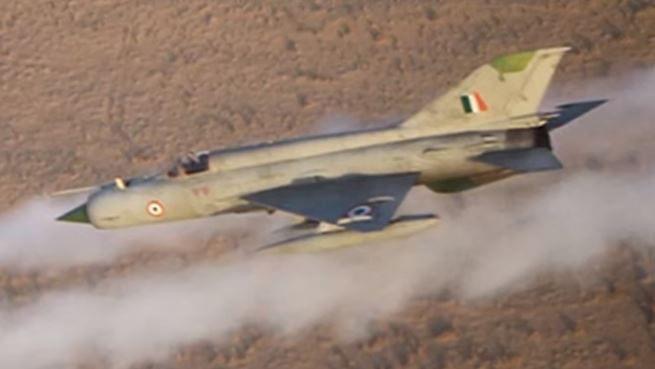
The Indian air force is in the midst of a massive modernization and expansion effort.
India has focused on archrival Pakistan for decades, but it is now contending with a much larger foe: China.
Earlier this month, at the end of India's annual Independence Day parade in New Delhi, the Indian Air Force showed off its aircraft inventory in multiple flyovers of the Rajpath, a ceremonial boulevard in the capital.
The flyovers included transport aircraft, helicopter gunships, fighters, and fighter-bombers. It was the latest show of force for a military branch that, like its naval counterpart, is in the midst of a massive modernization and expansion effort.
Focused for decades on the threat from archrival Pakistan, India is now preparing its air force to fight another much larger foe: China.
With roughly 2,000 combat aircraft from its air force and navy, China has the largest aviation force in Asia and the third largest in the world. Worse for India, China's increasingly close relationship with Pakistan is resulting in closer military cooperation, including joint development of fighter jets.
Faced with the potential for an air war against two enemies, the IAF is increasing its size.
With well over 1,000 aircraft itself, the IAF is by no means small. Since India's independence, it has mostly fielded Russian aircraft made entirely in Russia or licensed for local production.
Even today, the biggest fleets in the IAF inventory are those of the MiG-21, MiG-29, and the Su-30MKI — a version of Russia's Su-30 made specifically for and by India. (India signed a contract for the Su-30MKI in the 1990s and has built more than 200 of them domestically since the mid-2000s.)
The service also has some European models, such as SEPECAT Jaguars and Mirage 2000s, which are the IAF's primary strike platforms. But those aircraft, which were acquired in the 1980s, are showing signs of age, and the IAF plans to retire them by 2030.
India's MiG-21s, first introduced in the 1960s, are also expected to be retired by 2030 — even the modernized MiG-21 Bison models. The jet has a poor safety record; as of 2013, more than 480 of India's MiG-21s had been involved in accidents that had caused over 200 deaths.
The US paused F-16 deliveries in 1990 because of Pakistan's nuclear program, but they resumed in 2005, and the PAF now has some 75 F-16s. Their use is conditional and closely monitored by the US, but Pakistan would likely have no qualms about using them in an all-out war.
In 2019, a series of skirmishes between India and Pakistan included airstrikes on each other's territory and resulted in one MiG-21 Bison being shot down by PAF fighters, possibly by an F-16. It was the first time since 1971 that air attacks had been conducted across the Line of Control.
During the Cold War, China sold Pakistan its J-6 and J-7 fighters, which were Chinese copies of Russia's MiG-19 and MiG-21. The PAF has also benefitted from Pakistan's closer ties with China in recent years.
Their air forces regularly conduct joint exercises, and they have even jointly developed a fourth-generation multirole combat aircraft, the JF-17, of which Pakistan has over 100.
China and Pakistan are now planning upgrades to Pakistan's JF-17 fleet, and China has announced the sale of 50 Wing Loong II combat drones to Pakistan. Pakistan may also acquire Chinese strike aircraft.
China's own air force also poses a threat to the IAF. Particularly worrying for India are the J-10 and J-11 fighters and the J-20 stealth fighter.
The aerial threat from China was abundantly clear after last year's deadly standoff along its disputed border with India.
India has a longer history of air operations in the area, but China is rapidly building and expanding air bases and defenses along its western borders.
In 2016, India signed a contract with French firm Dassault Aviation four 36 Rafale multirole fighters. Twenty-six of them have been delivered so far, and some have already been deployed to counter possible Chinese aggression.
The IAF has also purchased 15 CH-47 Chinook helicopters and 22 AH-64 Apache gunships, both of which have also been deployed to the border region.
India has developed its own lightweight fighter jet, the HAL Tejas, and has about 20 in service. The original order for 40 fighters was supplemented by an additional order of 83 improved Tejas Mark 1A variants, with a second production line built to speed up production.
To meet its needs in the near-term, India is buying another 21 MiG-29s and 12 Su-30MKIs. It is also upgrading its MiG-29 fleet and modifying its Su-30MKIs to be able to fire Brahmos cruise missiles.
The US-made F/A-18E/F and F-15, the French-built Rafale, the European-made Eurofighter Typhoon, and Russia's MiG-35 and Su-35 — all twin-engine jets — are in the running, as are the single-engine Swedish-built JAS 39 Gripen and US-built F-21, a version of the F-16 designed specifically for India.
India also has a number of high-profile domestic projects in development. It plans to fly a prototype from its own fifth-generation stealth fighter program by 2025 and recently unveiled an unmanned fighter jet program.
India has relied on foreign suppliers for much of its military hardware — especially Russia, with which it has a longstanding but increasingly fraught relationship — but many of the new acquisition efforts will require some degree of local production as part of Prime Minister Narendra Modi's "Make in India" program aimed at boosting domestic manufacturing.
Amid ongoing tensions with China and renewed uncertainty about the future in Afghanistan, India's efforts to expand and modernize its air force show how serious it is about countering the threat from its two most contentious neighbors.

Be the first to comment